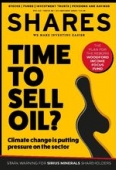Archived article
Please note that tax, investment, pension and ISA rules can change and the information and any views contained in this article may now be inaccurate.
What does a high share price mean?

A lot of investors presume that a stock priced at £10 is much more expensive than something priced at 250p. Yes, you need more money to buy a single share, but you can’t learn anything about how the equity is valued from its share price. Classic methods of valuing a company include comparing a share price to something else such as its earnings or dividends.
However, a high share price can potentially teach us something about a company’s success as we explain in this article.
First we must address some basic issues. To the less experienced investor it can seem confusing as to why there is such a large price range for stocks. If you went into two different shops looking to buy a t-shirt you might see a range of £3 to £30. But the gap between the lower and upper end of stocks can be significantly greater.
While you may be able to instantly tell if a t-shirt priced at £3 is inferior quality to one priced at £30 just by touching it or examining the material, you can’t do this with stocks.
Companies all have a different number of shares in issue. For example, Company X might have 1m shares in issue and trades at £10 a share, so its market value is £10m. Company Y might have 10m shares in issue and trades at 100p per share – its market
value is also £10m.
HOW HIGH DO PRICES GET?
Excluding investment trusts, the UK stock market’s highest price share is property company Mountview Estates (MTVW) at £116.50.
This might seem like a lot of money to purchase one share, but it pails into insignificance compared to Warren Buffet’s Berkshire Hathaway in the US, where you would need to fork-out $343,000 for a paltry single share.
Buffet created a different class of shares for Berkshire (called the ‘B’ shares) in the 1990s in order to help small investors get in on the action. They trade at $125 a share, but only carry a tenth of the voting rights of the original ‘A’ shares.
When most companies come to the market they generally want as many investors as possible to be able to purchase shares, so they tend to price their shares at a level that smaller investors can afford, usually around the £1 level.
Over time if the business does well, the share price tends to rise in tandem with the underlying profits and perceived future value of the firm.
To split or not to split
It became popular in the US and the UK for companies to ‘split’ their shares if the price got above £10 per share. This involves issuing more shares and reducing the price per share.
There is no sound reason why splitting shares creates any value. Let’s see why. Pharmaceutical company AstraZeneca (AZN) trades around £77 per share, and there are currently 1.29m shares outstanding, giving a market value of £99.3bn.
The company could rebase its share price to 770p by issuing everyone 10 times more shares, so that there are now 12.9m shares priced at 770p. The action wouldn’t change the value of the business.
The thinking was that investors might erroneously associate a high share price with a highly valued business and be put-off buying. Some researchers even found evidence that companies that split their shares tended to outperform those that didn’t.
Investors should be wary of companies that engage in reverse splits – increasing the share price and reducing the number of shares in issue.
These tend to be companies that have lost so much value that before the reverse split they had become penny shares. It’s often an attempt to disguise the poor performance of the business.
High prices tend to reflect past success, with some caveats
One thing that can be gleaned from a relatively high share price is that the underlying business has been successful, if we make two other assumptions.
We need to make sure that the company hasn’t just been issuing new shares to grow in value and we also need to eliminate those businesses that started with a relatively high share price in the first place.
Once we do that, we can reasonably say that high share prices tend to reflect a fundamentally sound business, one that has grown its value over time and provided strong shareholder returns. It also implies that management are focused on the business and not distracted by the share price or liquidity of the shares.
We used Stockopedia to screen for high share prices, removing those that simply issued lots of shares or began life with an already high price. The 20-year price performance of these shares greatly outperformed the average share over the period.
That’s very interesting data. However, as mentioned at the start of this article, you cannot tell from a share price if a company is a good value investment.
The high price might show a business has been successful in the past, but its shares may now be very expensive based on classic equity valuation metrics. Buying now would ultimately mean you could be overpaying for something, even if the business is very good.
We put stocks into different segments based on their current share price. Stocks below 100p in value include struggling companies with falling share prices as well as ones unfamiliar to most investors. The big returns are seen in the 500p to 800p range where five-year total returns are very good. That suggests the 200p to 300p stocks of today could be interesting hunting ground.
Important information:
These articles are provided by Shares magazine which is published by AJ Bell Media, a part of AJ Bell. Shares is not written by AJ Bell.
Shares is provided for your general information and use and is not a personal recommendation to invest. It is not intended to be relied upon by you in making or not making any investment decisions. The investments referred to in these articles will not be suitable for all investors. If in doubt please seek appropriate independent financial advice.
Investors acting on the information in these articles do so at their own risk and AJ Bell Media and its staff do not accept liability for losses suffered by investors as a result of their investment decisions.

 magazine
magazine










